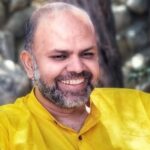Up until last year, I had never heard of an Ishta Devata. Who could it be, how do I find it, if what it is was unknown? But my Ishta Devata revealed its full glory, one spring night, when after a walk by the River Hudson, I entered my apartment filled with smoke. Smoke hanging in air like dancing pixies.
Soot on couch and soot on books, soot on rug and soot everywhere. Soot so black and smoke so bitter, I remember thinking as I noticed the smoke detector with its battery popped out. It clicked and then it all made sense.
Now before that, I had never felt the need of a personal deity. Deities should be no less than 33 million to keep us busy for the thirteen festivals in twelve months, was the overworked cultural maxim, we relished. But for the past one year, as I began diving into the vastness of Indic thought, Ishta Devata started appearing here and there. Soon, as it came to be, everywhere—meeting outside, what was thus always inside.
“Among us there is the concept of the Ishta Devata or the particular form of God which one chooses for his worship and meditation. To get at the One supreme, you must start from some manifestations of it and you choose it as your Ishta Devata. Another man may choose some other manifestation. As each progresses in his devotion and concentration, he will be led on to the One where the differences disappear. This is the experience of all the great sages and saints,” are the words of Param Acharya of Kanchi, which were quoted by N.A. Palkhivala in A few moments with ParamAcharya.
I began investigating retroactively what manifestation I had chosen, had it always chosen me?
Praying was always so simple. In our convent school, we just had to recite Our Father in Heaven, during morning assembly under the hot sun; recite it once more with a hungry belly before tiffin time; then during afternoon assembly under an even hotter sun; and then at the end of school day, before we ran to line up for an overstuffed school bus. There was also a guardian angel in whose praise we sang hymns, and who we were told in our Moral Science class, was explicitly invisible but was definitely omniscient. I imagined the guardian angel to be a majestic eagle perched on my right shoulder, ready to poke the eye out of anyone dangerous. Because to me, the omniscient needed to be eagle eyed.
Technicalities aside, I don’t remember entrusting myself fully to the winged celestials, hymn or no hymn. But I surely remember the self-interest driven prayers, especially the Saturday-before-the-weekly-test-ones on knees.
Beyond the walls of the convent-guilt-ridden worship was the pagan world of gods, indubitably connected with delicacies and festivities, colours and firecrackers, including the much-awaited Durga Puja shopping spree for new dresses.
That Hindu world was a tad more complex. Because as I had understood then, among the pantheon of Indian deities there was no one hero, instead they were more like ministers with a dedicated portfolio. I had the privilege of appealing according to the dossier and the need of the hour.
Hence, much of my life I prayed to Goddess Saraswati, like millions of other exams fearing Indian youth. But so inward-looking was my devotion that if you asked me to point out Saraswati among Lakshmi and Parvati, I would have failed that test.
This one-track chapter was followed by a decade long wilderness, which was marked by my attempt to become a worldly citizen, with no Indian strappings. During this time, whichever religious festival coincided with my visit to India, was the one I indulged in.
Therefore, for the past year as I began the process of selecting some manifestation of the One Supreme to meditate with single-minded devotion, I was naturally so lost. Thus, began the flirtation.
Because the sun-less, grey winter of New York was sucking every molecule of luster out of me and filling me with a woebegone slump, I was convinced, all I needed in my life was the blessing of Sun God. It was so debilitating, that every morning when the alarm rang, I would push aside my blackout curtains and check if it would be a sunny day and if not, it was a default snooze. Of course, I loved the Surya Namaskar asanas, hence my Ishta devata had to be the Sun, also it was the lord of my seventh house, it sorts of again served some purpose.
Surya it was till my dishwasher broke the same week I got struck by the excruciatingly painful tennis elbow, so much so that in the mornings I could hear my bones pulsate and my teeth grit. I realized the love of my life had always been the dishwasher, and I remembered the god of motor vehicles was Vishwakarma. Now this machinery kept me on the path of sanity, hence I prayed whole-heartedly for the new appliance to cut through the collapsed supply chain of the pandemic and rescue me, which it did. I also stretched it to include all appliances and gadgets such as my laptop, camera and recorders that kept me mobile on the path of creative success. This made me think it was not really Surya that I could focus on, while I connected more with Vishwakarma. So, on and so forth.
My contemplation also led me to Ganesha and Lakshmi and back to Saraswati. Something did not settle inside me. While my faith was slowly deepening, the process of finding a symbolic value was eluding me.
Is this Ishta Devata outside or inside? It is here the discourse with Raghu Ananthanarayanan became instrumental, who pointed to the following Sutra.
svAdhyAyAt-iShTa-devata-samprayogaH
स्वाध्यायादिष्टदेवतासंप्रयोगः ॥ ४४ ॥
Patañjali Yoga Sutra 2.44.
When one understands oneself profoundly and subtly one becomes capable of manifesting one’s divine consciousness.
svAdhyAyAt: reading and chanting sacred texts and reflecting on it so that one gains insight into oneself
iShTa: Desired, chosen
devatA: Divinity
samprayogaH: Union, fusion, acting with
In Raghu’s words, “Through understanding myself more and more deeply I get in touch with devata within me. This brings me closer to my divine nature and this helps me to understand the Ishta Devata within, and this energy begins to express through me. A simple way of understanding this sutra is that through self-awareness my gifts get revealed and this helps me to achieve my highest potential. The Ishta Devata is symbolic of the highest and purest form of my capacities. It can also be seen as the most sattvic and luminous form of me. My body and my psyche become capable of being the vehicle for divine archetypes to be manifested and expressed.”
A more in-depth exploration of the Sutras can be found in Yoga Sutra for Inner Work, a blog curated by Anita Balasubramanian, which is based on the lectures by Raghu.
Am I trying too hard to project this powerful energy inside me into a postulation outside?
Raghu helped me understand that the Ishta Devata is my inner essence, the Swaroop or light form. “It is archetypal in the sense it is not your yours. The self we call as ours is in the asmita level. So behind and beyond this ahankara is the Ishta Devata. It is the essence of your true self.” Once the compulsiveness from this powerful energy is stripped, the beauty of the energy becomes available to us.
But how does one navigate this journey and decipher the cues and the prompts?
“Just meet and say hello to it and things will happen,” Raghu insisted, making the process more lighthearted than my mind was allowing it to be. The compulsion to find the ‘energy without compulsion’ just kept popping the question thisway, thatway, anyway—who is it?
“One of the ways, it will appear in your dreams in some form and there are some external things you are attracted to with no reason. These are all indicators of the energy inside you,” he added.
It is when I stopped forcing the process and let the process settle me, it began to unveil.
Like seeing the flashlights and shapes through a foggy morning, the images and meanings started embracing me, with no particular order or precision but a reinforcing resonance of love.
I had always believed that the best creative mind is the androgynous mind and I have been carefully nurturing that duality within. For assurance I had always looked up to Ardhnarishwar. Every single time I heard the Uma Maheshwara Sutram, the shyness of my body would evaporate, allowing me to tap, jiggle, sway and sing along. The first time I heard the Shiva Tandava, I experienced what is the ultimate longing. If anyone asked what is the most amazing place that I have traveled to, the answer would always be the one I wish to: Mansarovar. What is romance? The way Shiva looks at Parvati.
More importantly, in moments when I had to pull myself through the bootstraps and fight and charge ahead, I had always imagined a form, with an erect back, an untamed energy, with stealth and raging anger, as steely as Shiva, waking up within me, that made me fearless in the face of fear. In dreams and in daydreams, throughout my life.
But it is in the last one year, that I had fully entrusted myself to Shiva without knowing I had. I struggled with memories of hurt and grief for lost loved ones and the things that should never have been and the things that could have been. As usual I took my query to Jay Shankar, an explorer of Indic traditions, with whom I have engaged in many dialogues on the philosophies and practicalities of life. What do I do with memories?
Shankar suggested that I dedicate my morning pranayama practice to Shiva. He asked me to go back to all those memories, sad and happy, and just be with it, observe and breathe it out and offer it to Shiva and trust that Neelkantha would absorb it and absolve me of it as he did with the halahala.
So, I did, and spaces began clearing inside me, making way for the sprouting of new evocations.
These images and realizations were teasing me till that fateful fire. I had an altar in my apartment with images of few Hindu deities in metal and glass frames. I have been lighting a ghee lamp for the past four years. That evening, the frame of Shiva caught fire, melting metal, wood, paper and glass. Keeping intact and safe all other frames and idols despite the edges touching each other.
As I walked into the apartment, the enormity of what I was saved from, filled me with grateful devoutness. The fire alarm was a double-edged sword. I had removed the batteries temporarily because that morning I used the oven and the heat always sets it off. But with no alarm, the wooden walls would have burned down. But it didn’t and no one was harmed. The incessant alarm and the smoke could have alerted the neighbors and the manager. Now that in America means less of neighborliness and more of negligence lawsuits. Given the rug under any immigrant is always being pulled and we have to pull it back with feet and fists, I was saved. Of course, common sense was drilled into me to never leave an unattended lamp.
But inhaling the smoke and exhaling the fear, I was standing there alone, as calm as a spring daisy. The power of destruction and protection, cohabited within me, and safeguarding me from the manifested fears.
I was awed. And humbled.
I am often overflowing with the beauty of the ode to Shiva as expressed in the “Atma Shatakam or Nirvana Shatakam (The Song of the Self),” by the eight-century philosopher Adi Shankara
aham nirvikalpo nirakara rupo
vibhut vatcha sarvatra sarvendriyanam
na cha sangatham naiva muktir na meyaha
chidananda rupah shivo’ham shivo’ham
I am devoid of duality, my form is formlessness,
I exist everywhere, pervading all senses,
I am neither attached, neither free nor captive,
I am the form of consciousness and bliss,
I am the eternal Shiva.
Thus, I am now able to see that the pure gift that I am is my Ishta Devata—Shiva.
That this me is the expression and the manifestation of that Ishta Devata and thus the love of the Ishta Devata is always and has always been present. I am the expression of that energy and my journey is discovering that I am that expression.
Bio

Bijoyeta Sahoriya Das is an Assistant Professor and Program Director of Journalism at LaGuardia Community College, City University of New York. Prior to joining CUNY, Das worked as a journalist, photographer and media trainer for more than a decade. She reported from South and Southeast Asia, Turkey and the US, writing for Al Jazeera, Deutsche Welle, Radio France, Radio Netherlands among others. She trained journalists and developed local media institutions in South Sudan for two years.
Das writes long-form narratives, literary features and short stories, and wrote a creative non-fiction biography of Haiti’s first woman prime minister. Her work is available at www.bijoyetadas.com.


 Anoop is a student of Yoga, an entrepreneur, a coach and a father of two young boys. He has led successful leadership stints in both the corporate and non-for-profit sectors. On encountering the country’s water/farmer crises at close quarters, he decided to pause and examine the impact various ‘isms’ – capitalism, colonialism, etc., were having on us as individuals, families, the society and the environment at large. This quest led him to formally engage with traditional Indic knowledge systems while also learning from the latest advances in science – about our physical and mental wellbeing, importance of body and mind work in healing trauma and the urgent need for a conscious rebuilding of family / work / social structures if we have to thrive individually and collectively. Insights, frameworks and processes gleaned from these on-going studies, an anchorage in his own personal practice and his wide-ranging experiences is what Anoop brings to facilitation/coaching spaces in Ritambhara and his various professional engagements.
Anoop is a student of Yoga, an entrepreneur, a coach and a father of two young boys. He has led successful leadership stints in both the corporate and non-for-profit sectors. On encountering the country’s water/farmer crises at close quarters, he decided to pause and examine the impact various ‘isms’ – capitalism, colonialism, etc., were having on us as individuals, families, the society and the environment at large. This quest led him to formally engage with traditional Indic knowledge systems while also learning from the latest advances in science – about our physical and mental wellbeing, importance of body and mind work in healing trauma and the urgent need for a conscious rebuilding of family / work / social structures if we have to thrive individually and collectively. Insights, frameworks and processes gleaned from these on-going studies, an anchorage in his own personal practice and his wide-ranging experiences is what Anoop brings to facilitation/coaching spaces in Ritambhara and his various professional engagements.
 Priya is a Yoga therapist in the Krishnamacharya tradition. She adapts Reiki & energy work, Vedic chanting, life coaching & Ayurvedic practices in her healing spaces. She is committed to nurturing collectives that have the praxis of Yoga at their heart.
Priya is a Yoga therapist in the Krishnamacharya tradition. She adapts Reiki & energy work, Vedic chanting, life coaching & Ayurvedic practices in her healing spaces. She is committed to nurturing collectives that have the praxis of Yoga at their heart. Anisha has been on an exploration to understand herself through yoga for the last 15years which led her to teaching yoga, yoga therapy and inner work through yoga.
Anisha has been on an exploration to understand herself through yoga for the last 15years which led her to teaching yoga, yoga therapy and inner work through yoga. Apoorva chanced upon Yoga in her early 20s. A spark was lit within and there was no turning back. Her exploration led her to the Krishnamacharya tradition more than a decade ago. Curious about human behaviour and what drives it, she was thrilled when her search ended (and also began) when she first came upon the Yoga Sutra, which illuminated a path towards answering many questions that had been held for a long time.
Apoorva chanced upon Yoga in her early 20s. A spark was lit within and there was no turning back. Her exploration led her to the Krishnamacharya tradition more than a decade ago. Curious about human behaviour and what drives it, she was thrilled when her search ended (and also began) when she first came upon the Yoga Sutra, which illuminated a path towards answering many questions that had been held for a long time. Anita is a yoga teacher and therapist in the tradition of Sri.T.Krishnamacarya and Sri T.K.V. Desikachar, a Reiki practitioner and a Life Coach. She is also the founder of Vishoka, a center for learning Indic and energy-based frameworks for living and healing. Her deep concern for human suffering and the problems of unsustainable living kept her on the path of seeking an integrated approach to looking at life, living, learning and healing.
Anita is a yoga teacher and therapist in the tradition of Sri.T.Krishnamacarya and Sri T.K.V. Desikachar, a Reiki practitioner and a Life Coach. She is also the founder of Vishoka, a center for learning Indic and energy-based frameworks for living and healing. Her deep concern for human suffering and the problems of unsustainable living kept her on the path of seeking an integrated approach to looking at life, living, learning and healing. Ankit is a seeker in the wisdom traditions of India. The core of his work includes creating dialogic spaces where people can look within and see the connection between their inner and outer lives. Inspired by the likes of Gandhi, Aurobindo, Vivekananda and Guru Gobind his experiments in service took him back to his roots in Punjab where he is creating a community-led model of higher education which is open, inclusive and accessible for all. Ritambhara for him is a space for engaging in a community which is committed to a DHramic life. He anchors his work of learning and leadership in the Antaranga Yoga Sadhana and the humanistic wisdom of Mahabharata.
Ankit is a seeker in the wisdom traditions of India. The core of his work includes creating dialogic spaces where people can look within and see the connection between their inner and outer lives. Inspired by the likes of Gandhi, Aurobindo, Vivekananda and Guru Gobind his experiments in service took him back to his roots in Punjab where he is creating a community-led model of higher education which is open, inclusive and accessible for all. Ritambhara for him is a space for engaging in a community which is committed to a DHramic life. He anchors his work of learning and leadership in the Antaranga Yoga Sadhana and the humanistic wisdom of Mahabharata.
Beautifully expressed essay of coming to understand the significance did ourselves. What or who is the Ishta Devata – and acknowledgment of Its presence in us as the essence of who we are. Very helpful! Thank you!
Thats a very esthetically designed altar….specially loved ur brass uruli🙏
Thank you Bijoyeta for taking me along . Your journey is evocative and lit my path with a light that is gentle but strong. I am grateful for the sharing; the Shiva that you shaped in your narrative is so beautiful where the form dissolves into the formless and both are nourishment for me to continue my quest.
Beautiful.
What an incredible piece Bijoyeta. And thank you for attempting to explain the complexities with the underlying simplicity of personal stories and ancedotes. The last line is a favourite: “am the expression of that energy and my journey is discovering that I am that expression.”
Wish you the best with your endeavor, both literary and spiritual.
I havent thought of my Istha Devatha, but I know I am guided by wonderful and merciful powers!